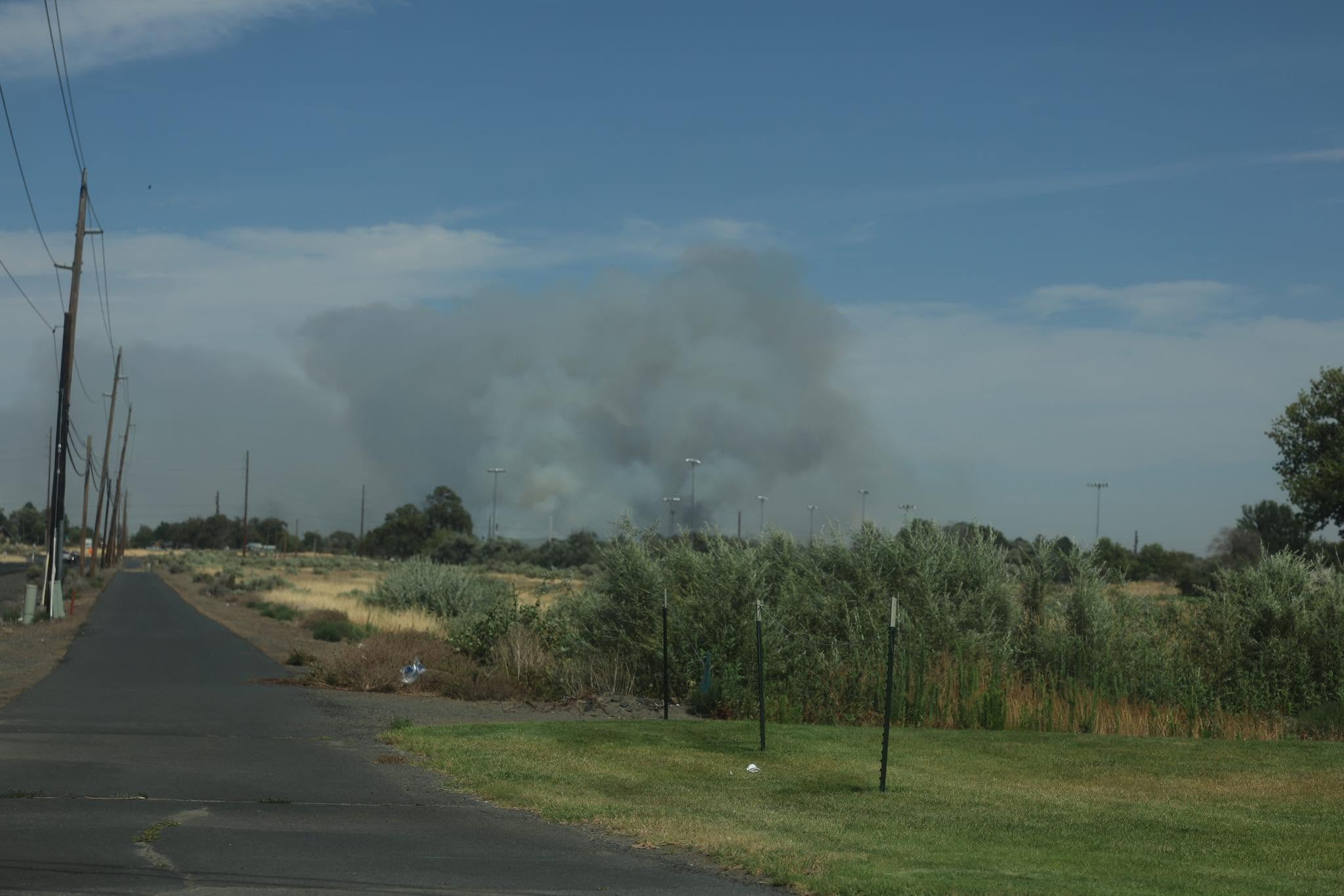After weeks of closures due to COVID-19, local businesses began reopening their doors Friday
Published 5:00 am Saturday, May 16, 2020

- Millie West gives a haircut at the Wagon Wheel Barber Shop in Pendleton on May 15, 2020. The barbershop, which has newly reopened, is making use of trash bags as disposable capes until they can find an alternative.
UMATILLA COUNTY — Following weeks of closures due to the COVID-19 pandemic, Umatilla County was back open for business Friday.
After Gov. Kate Brown’s delayed approval of the county’s application to enter Phase 1 of reopening Thursday, some business owners were welcoming customers through their doors Friday for the first time in months.
But burdened with requirements of personal protective equipment, limited capacity inside businesses, a short turnaround to prepare for these requirements and a general uncertainty about how the community will react in this first phase kept other businesses shuttered on day one.
“Everybody’s doing something a little different,” said Cheri Rosenberg, executive director of the Pendleton Chamber of Commerce. “We’re definitely seeing businesses trying to balance that hard line of wanting to reopen for the community with wanting to keep the community safe.”
The first phase of Brown’s plan allows restaurants, bars, personal service providers and retailers to reopen with modified accommodations specific to each business sector.
Despite extensive protocols changing the way they do business, the reopening of Wagon Wheel Barber Shop on Southeast First Street in Pendleton prompted an early morning line of residents who had been waiting for a haircut since March.
“Everything’s had to change,” said Olivia West, whose mother owns the shop and was seated outside Friday keeping a list of customers’ names and contact information.
For tracing purposes in the event of a future COVID-19 outbreak, Brown’s plan requires personal service providers like hair salons and barber shops to ask customers COVID-19 screening questions and record client contact information.
Personal service providers also must require employees and customers to wear face coverings, and salons and barber shops specifically must use disposable capes to catch fallen hair. Wagon Wheel had been preparing for restrictions to be lifted for over a week and managed to gather some supplies, West said, but not enough for many customers and staff who have turned garbage bags into capes for now.
“We have a very limited supply,” West said of the shop’s protective equipment.
A haircut was near the top of the list of things that Larry Koehne, 72, was needing as business began reopening Friday, so he decided to drop in at the Wagon Wheel on Friday and had no problem dealing with the new accommodations.
“Life is going to be different now,” he said. “It’s just going to be a part of life. It’s a new reality.”
Robbin Feruigson had help from the city of Pendleton’s business assistance grant in cleaning and preparing her store, Pier 104 on Southeast Court Avenue, to that new reality and was open Friday. The boutique store and tanning salon also leases space to local hairdressers, cosmetologists and nail technicians, so it’s dealing with a myriad of new requirements.
Along with Ferguison and her staff wearing masks and gloves, limiting the number of customers in the store at one time so they can maintain social distancing, and generally increasing sanitation protocols as all Oregon retailers must, she said Pier 104 is cleaning its tanning beds twice between every use.
“The thing is I ordered all these supplies when we first shut down,” Ferguison said. “I knew we would need them.”
Other retailers, such as Cheryl Stewart and her flower shop Calico Country Designs, returned Friday after offering delivery services over the past two months. Stewart said that she did all the deliveries herself, and though she’s opened back up for customers to browse, she’s only brought back one employee to help while she waits to see how Phase 1 goes.
“I just don’t know at this point,” she said.
Judy Currin-Pederson, owner of Lucky Endz Gifts in Hermiston and president of the Hermiston Downtown District, reopened her store Friday for the first time since March 23.
She said in accordance with the governor’s guidelines, she and her staff are wearing masks and cleaning surfaces frequently. She has also posted signs reminding people to follow social distancing guidelines, and has hand sanitizer at the front door and other locations inside the shop for people to use if they wish.
“I want our customers to feel safe, and our employees to feel safe, but we are happy to be open, for sure,” she said.
The downtown district handed out packets to its members on Friday that included helpful information for business owners, a sign to let people know they had reopened and signs in English and Spanish to hang inside their business reminding people to stay 6 feet apart from other customers and stay home if they are sick.
Currin-Pederson said some businesses reopened immediately on Friday, while others said they needed a few days to be ready. She said all the downtown merchants have been very grateful for the support from the community they have experienced in recent months.
“I’ve had some customers today saying they are going around and buying something from everyone who opened,” she said.
After converting to takeout and delivery only during the business closures, OMG! Burgers & Brew in Pendleton was one of the restaurants to open for dine-in seating Friday and a steady flow of customers streamed in throughout the day.
“Everything went really well,” said Kimberly Burt, the restaurant’s owner. “Everyone’s been so sweet and nice. I think everyone’s just happy to be out.”
Bars and restaurants wishing to serve people on site must separate tables by 6 feet, limit groups to 10 or fewer and end on-site consumption by 10 p.m. Buffets, salad bars, soda machines and other self-service operations are prohibited during Phase 1, and condiments are required to be served in single-serving packages or disinfected between each use. Napkins, utensils and glasses also won’t be allowed to be preset at tables.
Burt said she had to lay off half of her staff during the closures, all of whom have now been rehired and will be back to work during this new phase.
“That’s why we’re reopening — we knew our employees needed to get back to work,” she said.
But while Burt and her restaurant had a building conducive for meeting the social distancing requirements and already had equipment on hand for staff to serve the public safely, others in Pendleton are still navigating the changes.
Rosenberg said businesses have been mixed on deciding whether to reopen due to a litany of factors the new guidelines present, especially for restaurants facing the conundrum of trying to make a profit with reduced seating.
However, the Pendleton Downtown Association is hoping to address that problem.
Executive Director Wesley Murack confirmed in an email that the downtown association is working alongside the city, the chamber of commerce, Pendleton police, fire and public works departments and local businesses to develop a “temporary outdoor seating section program.”
The program would mean that Main Street in Pendleton would be closed off from traffic to allow for more seating that meets the social distancing requirements, while simultaneously promoting a welcoming environment to stimulate business in the area.
“The effects from the recent shutdown will be felt for many months yet, and the key to our community’s recovery is improving our community’s connection to our downtown businesses,” Murack wrote in an email. “By creating a vibrant atmosphere focused on pedestrians instead of vehicle traffic we can reduce the impacts on the shut down and help our community to recover quickly.”
While the outdoor seating program is still in the works, Rosenberg said that ultimately many businesses may opt to wait until the second phase to reopen.
The county will remain in the first phase for at least 21 days to monitor how it responds to the gradual reopening before being considered for the second phase, which could include the increase of gatherings to 50 people and relaxing suggestions against nonessential travel.
While in the first phase, people are advised to continue social distancing, working from home when possible, and limiting nonessential travel. Gatherings of more than 25 people are also prohibited, and people are still advised to limit gatherings to less than 10.
Schools and playgrounds will remain closed, while youth activities and visits to hospitals and long-term care facilities are also still prohibited. Large venues and movie theaters won’t reopen during the first phase, either.
“Now, our ability to reach Phase 2 will be totally dependent, I think, on how well we continue to follow those guidelines,” Umatilla County Commissioner George Murdock said.
While local businesses and their customers were rejoicing in the lifted restrictions Friday, the Umatilla County Public Health Department announced another three confirmed cases of COVID-19. That brought the county total to 93, a press release stated, 15 of which are considered active and one that is currently hospitalized.
As people begin to leave their homes more and return to some of their social routines, albeit in a modified fashion, health officials aren’t expecting new confirmed cases to cease.
“We’re going to see additional cases,” said Joe Fiumara, Umatilla County Public Health director. “We have to stay on top of this so we don’t go backward. That would be worse than having never got the opportunity to reopen (Friday).”
What remains unclear is how closely the rise in those new cases will be monitored by the state and how significant of an increase would actually trigger a step backward from Phase 1. Fiuamra said the metric provided by the state is a 5% increase in confirmed cases over a seven-day span, which would equate to just about five new cases for Umatilla County.
“I’m hoping it’s not a completely white and black line they’re going to take with it,” Fiumara said.
But on Friday there was a sense of excitement among the local business community that for the first time in months, things were somewhat normal and there’s at least some hope that day will actually come eventually.
“We’re seeing there’s maybe a light at the end of the tunnel, and one that’s hopefully not coming from a train,” Rosenberg said.









